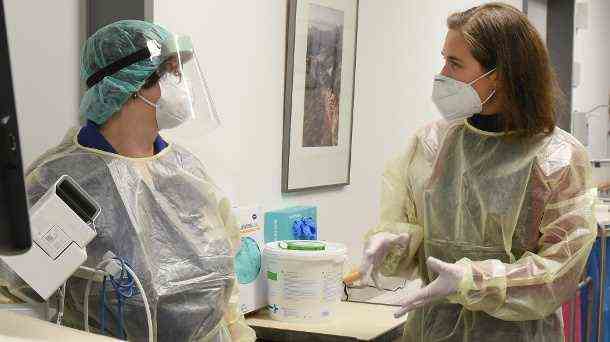The corona situation in Germany is serious, but that is apparently only the tip of the iceberg. Due to the overload of the health authorities, the number of unreported infections is higher than ever.
When the seven-day incidence of new corona infections fell for the last three days in a row, many hoped for a trend reversal. Even experts referred to the so-called R-value at the beginning of the week, with which the Robert Koch Institute (RKI) calculates the average number of people infected by an infected person. It had sunk below the magical limit of one.
But RKI President Lothar Wieler destroyed this illusion on Friday. The figures are currently not as reliable as usual. In some regions, he reckons with an “under-reporting” of cases by a factor of two or three. In plain language: The number of 74,352 new infections reported on Friday could actually be much higher. After late reports, the RKI later corrected the R value reported at the beginning of the week upwards – above the value of one.
The number of unreported cases has never been so high
Since the beginning of the pandemic, the RKI has pointed out that only positive tests registered by the health authorities can be recorded. So there has always been a certain number of unreported cases, stressed the Managing Minister of Health Jens Spahn on Friday. But the situation changed dramatically in December 2021 – paradoxically, positively and negatively.
On the one hand, there are many more people who have been vaccinated: the likelihood that an infection will lead to symptoms or a severe course of the disease has decreased significantly. The crux of the matter is that people usually only get tested when they feel sick. The number of unreported cases rises to the extent that people are reasonably protected. But people with so-called vaccination breakthroughs can also infect others.
Queuing in front of a vaccination center in Laatzen: Experts fear a high number of unreported cases of corona infections in Germany. (Source: dpa)
In addition, unlike in previous pandemic waves, day-care centers and schools will remain open this time – with children, some of whom cannot be vaccinated. Therefore, the highest incidence values are currently found in the age groups up to 18 years. In these cases, the disease progression is also not as serious as in older unvaccinated people. But children can also infect educators and parents and thus spread the virus. The value of more than 21.1 percent positive test results reported by the laboratory association ALM indicates that the pandemic is spreading very widely. For comparison: the previous high was at the height of the second wave at the end of last year at 16.45.
Overtaxed health authorities
In addition, there is the current excessive demands of many health authorities. In a number of federal states, authorities have not only stopped tracking the contacts of infected people, but are also unable to keep up with the daily recording of the number of cases, warned the chairman of the Federal Association of Doctors in the Public Health Service, Ute Teichert, on Wednesday. The Robert Koch Institute relies on these figures for its daily published figures.
 Intensive care unit in Wittenberg: The hospitals are fighting for capacities in the fight against the fourth corona wave. (Source: dpa)
Intensive care unit in Wittenberg: The hospitals are fighting for capacities in the fight against the fourth corona wave. (Source: dpa)
The problem primarily affects the areas most severely affected by corona, which, like in Saxony, sometimes have seven-day incidences of 2,000. A spokeswoman for the Saxon Ministry of Social Affairs confirmed that a number of health authorities had asked the Bundeswehr for personal help. With this support, “the majority of the Saxon health authorities” are now able to cope with the current data entry of the newly added cases. Conversely, however, this means that quite a few offices still fail to do this.
Bottleneck: laboratories
“There is another factor – the test laboratories,” said the spokeswoman for the Saxon Ministry of Social Affairs. “There are time delays in processing the PCR tests. The East Saxon area in particular is exposed to maximum loads.” This, too, is actually obvious. In counties where there are a lot of cases, such as in Saxony, Thuringia, Brandenburg, Saxony-Anhalt or Bavaria, more and more PCR tests are ending up in the laboratories for evaluation. The board member of the nationwide laboratory association ALM, Jan Kramer, speaks of an occupancy rate of 85 percent. “It’s not feasible for a long time,” he told Reuters. In some federal states, the laboratories are “already much more than 100 percent full”.
“The limiting momentum is the availability of staff,” says Health Minister Spahn. Because the flood of tests in a Bavarian border district badly affected by Corona is not sent to the less busy laboratories in Schleswig-Holstein. So many tests were left behind for now. Without a test result, infected people do not appear in the statistics of the health authorities and thus the RKI. It could be that not all test results are available in all regions within 24 hours, admits ALM board member Kramer. “These are usually processed within 48 hours,” he emphasizes, denying at least a significant backlog.

